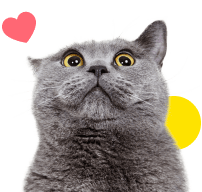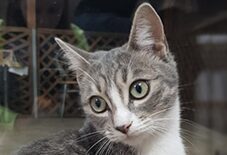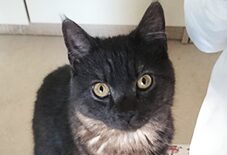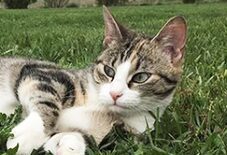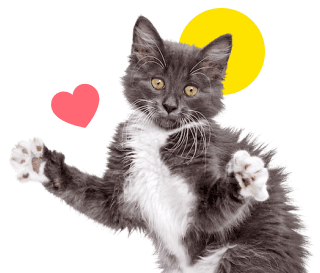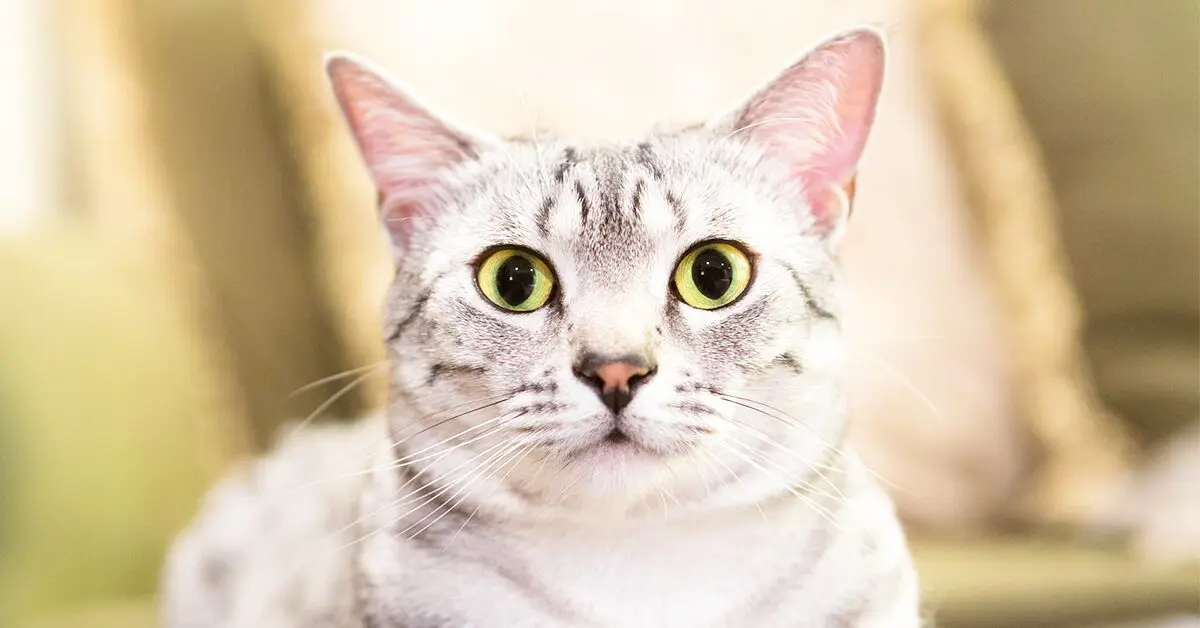
Meet the Egyptian Mau
Best Fur Friend
High Kitty I.Q.
Star Cathlete
Want a playful and athletic cat with exotic, low-maintenance looks? Then I’m the breed for you! We Egyptian Maus may look like wildcats (we’re the only naturally spotted domestic cat breed), but don’t let my cheetah spots fool you – I’m all housecat! I’m great with kids and cat-friendly pets, but I can be shy and sensitive around strangers. Socialize me early with other humans so I get used to meeting new friends.
I’m also a smarty paws with lots of energy, so I’ll need puzzle toys to keep my mind active and chase toys, scratching posts, and a tall cat tree (I can jump up to 6 feet!) to help me get it all out. I love interactive play with my humans, and love to run around – after all, I’m the fastest domestic cat in the world, with a top speed of up to 30mph! I can also be chatty – I make a chortling sound that humans love – and I’ll even jump on your shoulders if I’m especially excited to see you! I may be a rare breed, but humans lucky enough to find me will make a furever friend.
Ready to learn more about me? Let’s dig in.
Ready to learn more about me? Let’s dig in.
 My Many Looks
My Many Looks
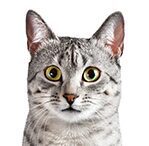
Silver

Bronze
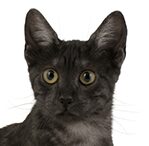
Smoke
 My Breed Characteristics
My Breed Characteristics
 Furbulous Fact
Furbulous Fact
We Egyptian Maus have a striking look that the humans go wild for, but it’s not just our trademark jungle-cat spots that make us so furbulous – we also have unique facial markings that make us stand out. We have a distinctive M-shape on our foreheads, which some humans call “the mark of the scarab” after the sacred beetle worshipped by ancient Egyptians. We also have “mascara” lines that stretch from the corners of our gooseberry-green eyes across our cheeks. Some humans even claim that our look inspired Egyptian women to style their own mascara after us!
 As I Grow Up
As I Grow Up
As you can see, we Egyptian Maus age pretty gracefully. Here are a few key milestones in my growth & development to be aware of as I grow up from a kitten to an adult and senior!
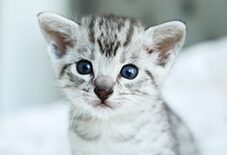
Kitten3-6 Months
I’m wary of strangers, so socialize me early with other humans!
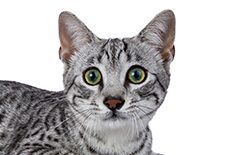
Adult1-1.5 Years
I’m an active high-energy breed and I love to jump and climb. Make sure I have lots of toys and a cat tree to keep me occupied.
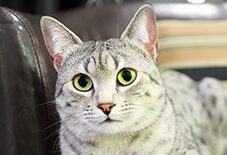
Senior8-9 Years
This is a great time for my human to start taking me to twice-yearly checkups, including screenings for my breed’s potential heart problems.
 History of My Breed
History of My Breed
As you might have guessed, we Egyptian Maus come from Egypt. What you might not know is that “mau” is the Egyptian word for cat! Since our breed is so old, the humans don’t know our exact ancestry – though, like all cats, we have African wildcat blood. What the humans do know is that we were very popular in ancient Egypt. My ancestors were depicted in ancient Egyptian art, and human archaeologists have found some of them buried in tombs alongside their humans. This, in addition to our regal looks, is where we get the nickname “Pharaoh Cat”!
We also have a lot of unique features that have appealed to the humans over the centuries. We’re the only naturally spotted domestic cat, for one – that means our spots exist without genetic manipulation through breeding. (That’s how Bengals got their spots.) We also have a unique gait because our back legs are longer than our front legs. The humans find this endlessly amusing because it makes us look like we’re walking on tiptoes! We also have a flap of skin that runs from our flank to our knees – just like cheetahs – which is partly why we’re the fastest domestic cat.
As popular as we were in the ancient world, we only became well known in the modern world after Russian princess Nathalie Troubetskoy was given a silver Egyptian Mau kitten named Baba while in exile in Italy. When she moved to America in 1956, she took Baba and two of her kittens with her. She loved our breed so much that she started her own cattery and wrote the breed standard. The Cat Fanciers’ Association (CFA) officially recognized us in 1977, and The International Cat Association (TICA) followed suit two years later. While we’re still a relatively rare breed, Mau-lovers worship us almost as much as the ancient Egyptians did!
 Pawesome Cats to Parent
Pawesome Cats to Parent
In addition to purebred Egyptian Maus like me, there are tons of prrrfectly sweet mixed-breed Maus that are looking to find their furever homes. You can learn where to find your next pet below!
Look out for heart murmurs & consult a cardiologist if your Mau has one.
Egyptian Maus are prone to a condition called hypertrophic cardiomyopathy in which chambers in the heart become abnormally thickened. The first sign of this condition is usually a heart murmur, which your veterinarian will be able to hear with a stethoscope during a physical exam. For a confirmative diagnosis of this disease, you’ll need to consult with a veterinary cardiologist.
Maus are very athletic & need lots of exercise.
Egyptian Maus can run up to 30 miles per hour and their jumping ability is just as impressive. These active and inquisitive cats need plenty of interactive play and appropriate areas to climb in order to stay healthy. This will also help prevent feline obesity, which affects all cats regardless of breed.
Be careful with anesthesia – Egyptian Maus are more sensitive to it.
Egyptian Maus are more sensitive to anesthetic drugs compared to other breeds. While you can’t always avoid anesthetic procedures, brushing your cat’s teeth can help reduce the likelihood of needing dental cleaning that requires general or injectable anesthesia.

 Why Get Cat Insurance?
from Pumpkin®
Why Get Cat Insurance?
from Pumpkin®
While Egyptian Maus are a generally healthy breed, cat-astrophes can happen to any cat at any age. If your kitty gets hurt or sick, pet insurance can help you say ‘yes’ to the best care, even when it’s costly. When it comes to shopping for this breed, you’ll want to choose insurance plans like Pumpkin's, which can help cover the costs associated with the hereditary conditions Maus are prone to developing. While a reputable breeder will conduct genetic testing on your kitty’s parents to help minimize the chances of passing down hereditary conditions, they can’t always be avoided. Let’s look at some common ones, and how Pumpkin Cat Insurance plans could help cover the cost of care!
 Heart Disease
Heart Disease
Maus may develop heart problems, specifically Hypertrophic Cardiomyopathy (HCM). In this condition, the muscle walls of the heart thicken causing a decline in cardiac function. While there is no cure, heart disease can be managed with medication and dietary changes.
- Cost to Treat
- $500-$3,000
- Pumpkin Pays Back*
- $450-$2,700
 Diabetes Mellitus
Diabetes Mellitus
Cats with Diabetes do not produce enough insulin to convert the glucose (sugar) in their blood into cellular energy. This can cause excessive urination, weight loss, and can lead to various infections. Diabetes can be managed with diet change, weight loss, and insulin injections.
- Cost to Treat
- $500-$5,000
- Pumpkin Pays Back*
- $450-$4,500
 Periodontal Disease
Periodontal Disease
Periodontal (gum) disease occurs when plaque builds up, forming a layer of tartar that inflames the gums. Left untreated, gums weaken and separate from teeth. While routine brushing, cleanings, and antibiotic gels help treat milder cases, severe ones require surgery.
- Cost to Treat
- $400-$1,200
- Pumpkin Pays Back*
- $360-$1,080
 Urinary Tract Infections
Urinary Tract Infections
Urinary tract infections are very common in cats. While basic infections respond to antibiotics, others can be a sign of underlying problems including bladder stones or blockages that may need to be treated surgically.
- Cost to Treat
- $200 to $1,000
- Pumpkin Pays Back*
- $180-$900
*Example illustrates reimbursement of a covered vet bill at a 90% reimbursement rate, where the annual deductible had already been satisfied and the annual limit had not yet been met. Coverage and reimbursement results vary based on policy options.
